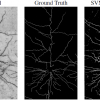Free Online Productivity Tools
i2Speak
i2Symbol
i2OCR
iTex2Img
iWeb2Print
iWeb2Shot
i2Type
iPdf2Split
iPdf2Merge
i2Bopomofo
i2Arabic
i2Style
i2Image
i2PDF
iLatex2Rtf
Sci2ools
CVPR
2009
IEEE
2009
IEEE
Learning Rotational Features for Filament Detection
State-of-the-art approaches for detecting filament-like
structures in noisy images rely on filters optimized for signals
of a particular shape, such as an ideal edge or ridge.
While these approaches are optimal when the image conforms
to these ideal shapes, their performance quickly degrades
on many types of real data where the image deviates
from the ideal model, and when noise processes violate a
Gaussian assumption.
In this paper, we show that by learning rotational features,
we can outperform state-of-the-art filament detection
techniques on many different kinds of imagery. More specifically,
we demonstrate superior performance for the detection
of blood vessel in retinal scans, neurons in brightfield
microscopy imagery, and streets in satellite imagery.
| Added | 09 May 2009 |
| Updated | 10 Dec 2009 |
| Type | Conference |
| Year | 2009 |
| Where | CVPR |
| Authors | François Fleuret, Germán González, Pascal Fua |
Comments (0)

